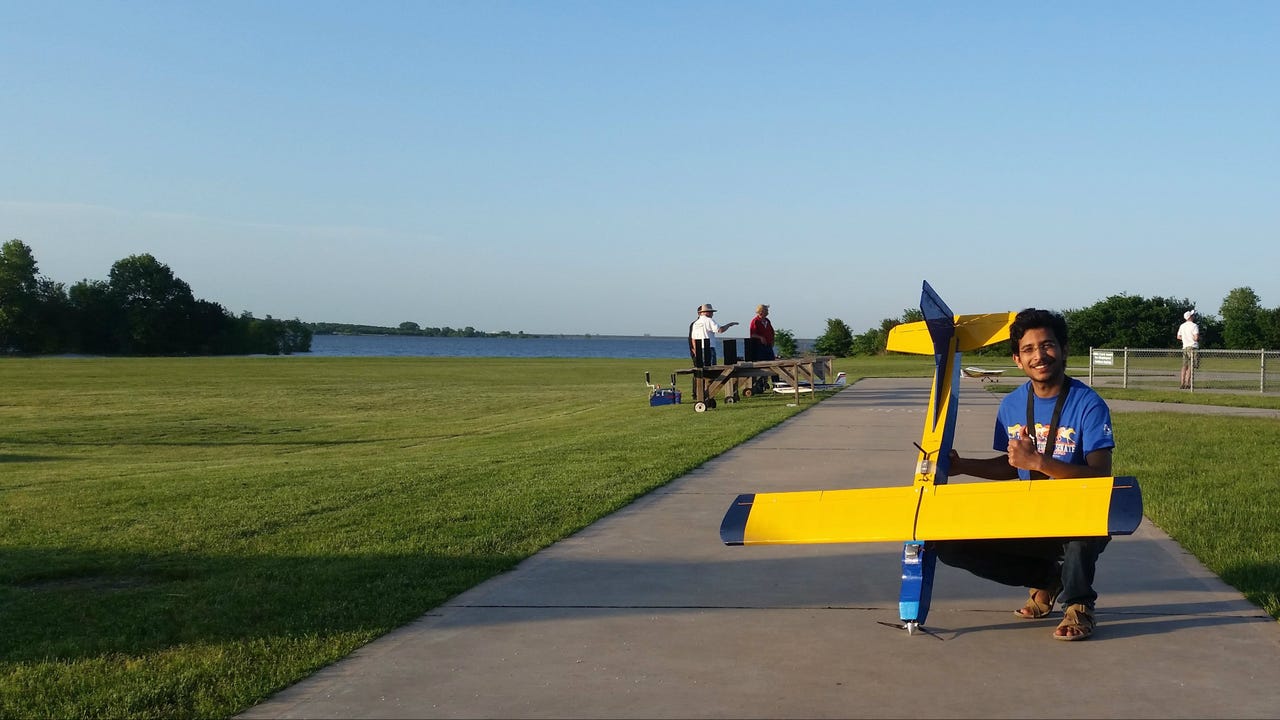New design could keep UAVs in the air


Sampath Reddy Vengate poses with his UAV that uses weights in the wings to maneuver. (Image: UTA)
Despite many recent advances, unmanned aerial vehicles (UAVs), a.k.a. drones, still have one big flaw: they can't stay in the air for long periods of time. The need to refuel or recharge limits many potential commercial applications since most drones can only fly short distances before they run out of energy.
This has led to some creative solutions, such as Amazon's plan for installing charging stations on lamp posts, but the underlying problem is the inefficient vehicle. A researcher from the University of Texas at Arlington has come up with a solution that is hidden inside an aircraft's wings.
See also
Sampath Reddy Vengate is the first person to successfully fly a UAV that uses mass actuation -- a technique that uses moving weights to efficiently turn an aircraft. Conventional aircraft design involves control surfaces called ailerons and elevators, which are movable parts near the edge of a wing and tail that help an aircraft turn in flight. This method works well, but it creates air friction (drag), which the aircraft must compensate for by using more fuel.
"Mass actuation is basically performing the same aircraft maneuvering without the use of conventional aerodynamic control surfaces," Vengate told ZDNet. His design is completely inside the wings, so drag is eliminated.
Vengate recently graduated from UT Arlington with a master's degree in Aerospace Engineering, a subject he told us he has been fascinated with since childhood. Before he started his undergraduate studies, he served in the air branch of India's National Cadet Corps. His training involved model aircraft, which is how his personal interest started to develop into a career.
He experimented with radio-controlled planes and started to attend university competitions "trying to crack through certain design, flying and control challenges". By the end of college, he won eight national-level competitions. However, his recent breakthrough in actuation was inspired by a failure.
As an undergrad, he entered a competition that challenged him to maneuver a UAV to carry an off-centered payload. He couldn't successfully handle the imbalance. This one-time failure became a launching point for a bigger idea.
"I missed the target and I realized that the ailerons, elevators of the aircraft can be completely replaced if I can develop a mechanism to perform the same actions as on a conventional aircraft," Vengate said in a statement.
This sleek design eliminates the moving parts that create drag on conventional UAVs. (Image: UTA)
Based on other research where fuel was redistributed to help stabilize an aircraft, Vengate wondered if he could build a UAV that uses weights in a similar way. He tested the theory with computer simulation, which showed that moving weights could work. He then designed a UAV using Computer Aided Design (CAD) tools and successfully tested it in the air.
Mass actuation would be ideal for high altitude, long-range UAVs, which can stay in the air for several days without needing to refuel. "This technology would help them reduce the drag, and hence, would let the aircraft stay in the air for longer duration with minimum use of fuel, which would help accomplish their mission," Vengate said.
The design could also be used in stealth planes, which are military aircraft designed to fly without being detected. Radar can detect conventional aircraft because the control surfaces move, but in mass actuation, the moving parts are hidden inside the wings.
Lastly, mass actuation could be applied to space shuttles. After completing missions in space, these vehicles enter the Earth's atmosphere at extremely high velocities, so any moving parts are prone to damage or failure.
So far, his invention has remained an academic accomplishment, but Vengate said he and his collaborators would love to partner with an aerospace company to commercialize the new design.